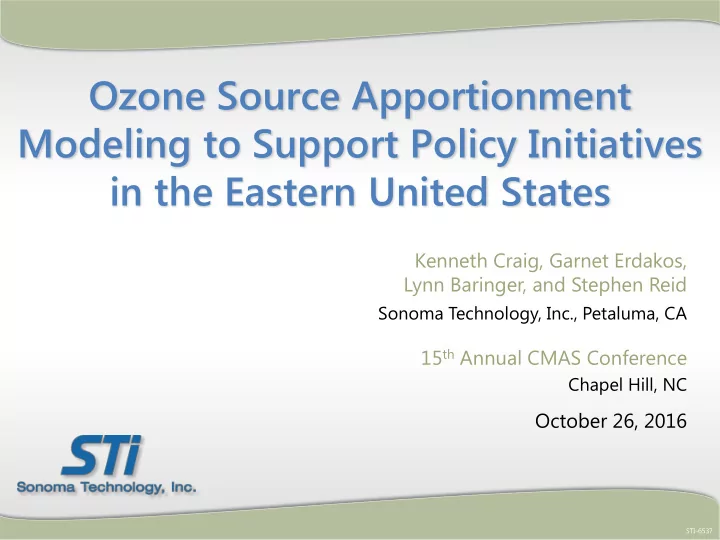

Ozone Source Apportionment Modeling to Support Policy Initiatives in the Eastern United States Kenneth Craig, Garnet Erdakos, Lynn Baringer, and Stephen Reid Sonoma Technology, Inc., Petaluma, CA 15 th Annual CMAS Conference Chapel Hill, NC October 26, 2016 STI-6537
2 Outline • Motivation • Modeling approach • Results: multiple sources examples • Results: single-source example • Summary and insights
3 Motivation • Interstate transport has become increasingly important for addressing NAAQS attainment issues. • Source apportionment has become an important tool to quantify source impacts on downwind ozone and guide policy decisions (e.g., CSAPR). • CSAPR modeling provides state-level source contributions. • STI conducted new source apportionment modeling with detailed tagging to support policy initiatives in the eastern United States.
4 Modeling Approach • 2011 ozone season (May- September) simulation with CAMx version 6.1 • Configurations based on EPA’s 2011 modeling platform – WRF version 3.4 – 2011 NEI Version 1 – GEOS-Chem boundary conditions – Carbon Bond 6r2 • Ozone Source Apportionment Technology (OSAT) with APCA APCA = Anthropogenic Precursor Culpability Analysis
Approach 5 Source Apportionment Tagging Category Tags Individual coal-fired power plants 52 Groups of coal-fired power plants 49 (several dozen EGU) Groups of non-EGU points sources 12 within a region Non-point sources (biogenic, 64 on-road, non- road, “other”) within 16 regions Initial and boundary conditions 2 OSAT regions for non-point source category
Approach 6 Source Apportionment Tagging Simulation Description 1 Point source tags (set 1) 2 Point source tags (set 2) 3 Geographic tags (e.g., on-road) • Processor: 16 CPU per simulation (2 nodes) • Memory: 10-12 GB RAM per node per simulation • Clock time: 3-4 weeks
Approach 7 OSAT Post-Processing Hourly gridded OSAT results Daily peak 8-hr O 3 contributions for each tag and receptor at hour of peak modeled 8-hr O 3 Receptor Locations (670 monitors in eastern U.S.) • Reflects contributions during time periods when ozone concentrations are highest • Guarantees that daily ozone contributions from all source tags sum to the total modeled 8-hr concentration
Approach 8 Access Database • Extracted ozone contributions for all tags at 670 monitoring sites across the eastern U.S. • Developed sample queries to facilitate data exploration • Opportunity for future data mining
Results: Multiple Sources 9 Ozone Impacts vs. Distance 1 ppb is the proposed NAAQS significant impact level (SIL) for single-source ozone impacts.
Results: Multiple Sources 10 Single Receptor Analysis Delaware sources Non-Delaware sources (6.11 ppb) Ozone contributions in Sussex County, DE, when modeled ozone was greater than 70 ppb (13 days)
Results: Single Source 11 Point Source Analysis Brunner Island • York Haven, PA • 1411 MW generating capacity • 2011 NO x emissions: 16,800 tons Brunner Island power plant in southeast Pennsylvania www.talenenergy.com and nearby air quality monitoring sites.
Results: Single Source 12 Brunner Island Ozone Impacts Peak modeled 8-hr ozone impacts from the Brunner Island power plant during the 2011 ozone season.
Results: Single Source 13 Brunner Island Ozone Impacts Peak modeled 8-hr ozone impacts from the Brunner Island power plant on July 20, 2011.
Results: Single Source 14 Daily Ozone Contributions Significant (>0.75 ppb) 8-hr ozone impacts were modeled at one or more PA monitor(s) on 86% (79 of 92) of days during June-August.
Results: Single Source 15 Ozone Contributions at Pennsylvania Monitors Significant (>0.75 ppb) 8-hr ozone impacts were modeled on at least one day at 75% of Pennsylvania monitoring sites. Maximum Number of AQS Site Monitor Modeled Core Based Statistical Area Significant ID County Contribution Impact Days (ppb) 421330008 York York-Hanover, PA 10.58 50 420431100 Dauphin Harrisburg-Carlisle, PA 6.70 31 420710007 Lancaster Lancaster, PA 5.56 36 420710012 Lancaster Lancaster, PA 5.17 31 420019991 Adams Gettysburg, PA 5.01 14 420750100 Lebanon Lebanon, PA 4.78 33 421330011 York York-Hanover, PA 4.65 48 420110011 Berks Reading, PA 3.93 22 420290100 Chester Philadelphia-Camden-Wilmington, PA-NJ-DE-MD 3.85 26
Results: Single Source 16 Impacts on High-Ozone Days Brunner Island Impact Monitor increment above NAAQS 10 ppb 6.70 ppb 6 ppb 5 ppb 3.34 ppb 1.44 ppb July 20 July 2 July 21 Modeled 8-hr ozone impacts >0.75 ppb from Brunner Island and incremental monitored ozone concentrations above the NAAQS on days when the NAAQS was exceeded at the Sipe Ave. monitor near Harrisburg.
Results: Single Source 17 Ozone Contributions on Neighboring States Max. # of Days With Average of Monitors with Peak Significant Significant Significant Ozone State Ozone Ozone Ozone Contribution Contribution Contributions Contributions (ppb) at any One (ppb) Monitor Pennsylvania 40 50 10.58 1.63 Connecticut 6 2 0.93 0.85 Delaware 7 28 4.83 1.69 Maryland 20 35 4.06 1.56 New Jersey 17 15 3.12 1.29 New York 16 6 2.31 1.00 Summary of significant (>0.75 ppb) modeled 8-hr ozone contributions from Brunner Island at monitoring stations in Pennsylvania and neighboring states.
18 Summary and Insights • Conducted source apportionment modeling to support policy initiatives in the eastern United States • Developed a database to support current analysis and future data mining • Multiple sources examples – 1-ppb impacts possible several hundred kilometers from large NO x sources – At some receptors, in-state ozone contributions are small compared to out-of-state contributions • Single-source example (Brunner Island) – Significant (>0.75 ppb) ozone impacts in Pennsylvania on most summer days – Significant impacts at Harrisburg on three NAAQS exceedance days in 2011 – Significant ozone contributions extend several hundred kilometers into neighboring states • Further discussion: Representativeness of modeling results from a transport perspective
19 Trajectory Spatial Probability Density (Difference plots: high-ozone days vs. all days) 2008 2011 Southwesterly transport toward Delaware is less pronounced in 2011 than in other years.
sonomatech.com 20 Contact Kenneth Craig Group Manager Atmospheric Modeling kcraig@sonomatech.com 707.665.9900 sonomatech.com @sonoma_tech
Recommend
More recommend